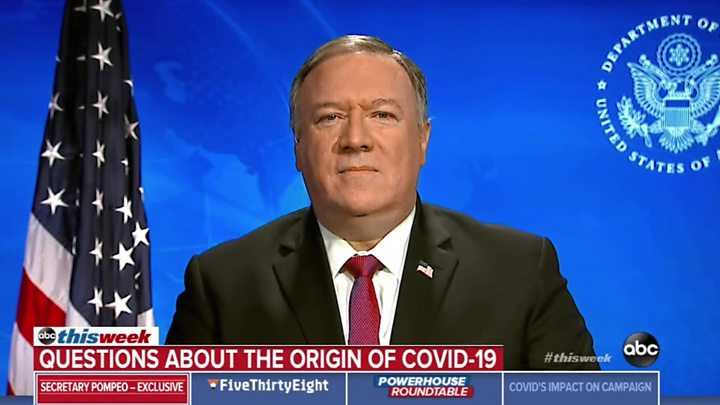Image copyright
AFP
China says calls for an investigation are a distraction from fighting the coronavirus
Global health leaders are pushing for an independent review of the response to the Covid-19 pandemic at the UN’s World Health Assembly.
Monday’s virtual meeting brings together envoys from 194 member states of the World Health Organization (WHO).
The WHO will face questions on how it dealt with the coronavirus pandemic.
Chinese President Xi Jinping, who has defended his country’s actions during the outbreak, spoke during Monday’s opening ceremony.
He said China had acted “with openness and transparency” and insisted that any investigation should happen after the pandemic was brought under control.
In other opening remarks, WHO Director-General Tedros Adhanom Ghebreyesus welcomed a proposed resolution calling for a review of the WHO’s handling of the pandemic and said it would initiate it “at the earliest opportunity”.
South Korean President Moon Jae-in said the WHO must be given more legal powers to ensure that countries report outbreaks and share data.
“A novel infectious disease could emerge at any time and we must be able to respond more quickly and effectively,” he said.
The two-day assembly – an annual meeting that reviews the work of the UN’s health agency – comes amid recriminations between the US and China over the virus.
The US has already stopped its funding for the agency and is promoting its own vaccine programme.
More than 4.5 million people have been infected and more than 300,000 have died since the virus emerged in China in December.
What is the assembly discussing?
The European Union, alongside countries including the UK, Australia and New Zealand, is pushing for an inquiry into how the pandemic has been handled and what lessons can be learned.
EU spokeswoman Virginie Battu-Henriksson said several key questions needed to be answered as part of any review.
“How did this pandemic spread? What is the epidemiology behind it? All this is absolutely crucial for us going forward to avoid another pandemic of this kind,” she said.
However, she added that now was not the time for “any sort of blame game”.
Image copyright
AFP
WHO director-general Tedros Adhanom Ghebreyesus has faced criticism for the agency’s handling of the pandemic
A draft resolution calling for a review, to be put to a vote on Tuesday, requires a two-thirds majority to pass and already has support from 116 of the 194 member states, according to Reuters.
Last month, an EU report accused China of spreading disinformation about the crisis.
The bloc’s External Action Service said Russia, and to a lesser extent China, had promoted “conspiracy narratives”.
War of words looms between US and China
Analysis by Tulip Mazumdar, BBC global health correspondent
The annual World Health Assembly is an important, but usually quite dry, event. Not this year.
The Covid-19 pandemic is taking centre stage and the event is likely to host a strong war of words between China and the US about how this health emergency has unfolded – with the WHO stuck in the middle of a bigger geopolitical fight between the superpowers.
The EU-led call for an investigation into the international response – and to find the animal source of Covid-19 – has been deliberately worded without mentioning China, where the virus first emerged.
Also expect calls for an independent WHO team to be allowed into China to investigate the origins of the virus. So far international teams have only been allowed in alongside Chinese authorities. The US and others including Australia will no doubt call for this, China is highly unlikely to agree.
What has the WHO said?
WHO spokeswoman Dr Margaret Harris said that the World Health Assembly was “always the time for a lot of scrutiny [of the WHO].”
But, she added, the organisation would remain “laser-focused” on working to lead the overall response, and on the science and solutions for this pandemic.
The WHO is supposed to represent the interests of all member states equally but has found itself at the centre of a political battle between China and the US.
US President Donald Trump, who faces re-election this year and has been criticised for his handling of the pandemic, has blamed China for trying to cover up the outbreak and has accused the WHO of failing to hold Beijing to account.
The row culminated last month with the US – the WHO’s largest single donor – pulling funding to the agency.
The assembly is also expected to hear calls to give the WHO more powers to allow inspectors to go into countries at the start of outbreaks, and carry out independent investigations.
The WHO did send a team of scientists into China in January and February, but it was a joint mission alongside Chinese officials.
What has China’s response been?
China has already rejected calls for an independent international investigation into Covid-19.
Last month, senior Chinese diplomat Chen Wen told the BBC that such demands were politically motivated and that an investigation would only divert attention and resources away from fighting the virus.
The outbreak first emerged in the Chinese city of Wuhan late last year and was widely reported to have originated in a food market.

Media playback is unsupported on your device
Since then, however, some senior US politicians have suggested that the source was a research facility in Wuhan that had been carrying out research on bat coronaviruses. China has dismissed the idea.
US Secretary of State Mike Pompeo said earlier this month that there was “a significant amount of evidence” that the virus came from a laboratory in Wuhan. However, in a TV interview with Breitbart on Saturday he appeared to step back, saying “we know it began in Wuhan, but we don’t know from where or from whom”.
The draft resolution mentions identifying “the zoonotic source of the virus and the route of introduction to the human population, including the possible role of intermediate hosts”.